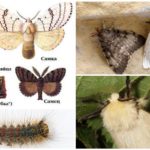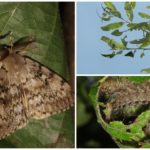Description and photo of the caterpillar of the Gypsy Moth
Content
- Gypsy moth
- Harm of an unpaired silkworm
One of the dangerous pests for the cultural and forest representatives of the flora is an insect called unpaired silkworm. It is quite widespread in European and Asian countries, it can be found in the north of the American and African continents. This caterpillar tracks settled in Russia, occupying a vast territory of the country.It causes significant damage to plants, especially those suffering from caterpillars of deciduous trees. If the insects do not have enough food, they move to coniferous youngsters, and, having penetrated into the nursery, they can cause serious damage to cultural plantings. If the unpaired silkworm eats the needles because there is no other food, then for Siberian silkworm any coniferous trees are the basis of the diet.
What is a pest?
Gypsy moth is a butterfly. It belongs to the Volnyak family, the order - Lepidoptera. The name of the insect was due to the fact that there are significant differences between the females and males:
- the female has a thick, massive belly, a large wingspan, which can reach 75-90 mm;
- the male is the owner of a thin abdomen, and the maximum wingspan is only 40-57 mm;
- in the female, the color of the wings is dirty-white, with black lines of zigzag shape visible on them;
- the color of the wings in males is brownish-gray with a pattern in the form of intermittent dark stripes.
Even if it is not careful to consider a photo of an unpaired silkworm, these differences are immediately evident.Butterflies give preference to dry places with a rare forest, plenty of daylight. By the number of breeding outbreaks, the silkworm occupies a leading position among this type of pest.
Interesting!
The male can be recognized by the antennae. They have a dark gray color and an unusual structure, thanks to which the individual male is able to detect a female, located at a distance of 11 km.
Gypsy moth at different stages of life
Heavy females fly infrequently. Mostly they spend time sitting on tree bark. They attract males by the smell of exogenous products (pheromones) that are able to excrete. The most active male gypsy moths in the evening. To find a pair, they are able to overcome long distances.
After fertilization, the eggs are laid high on the tree under the bark. They differ in a round form, have pink or yellow color. Females are very prolific, in one clutch there can be up to a thousand and more eggs. In this state, they spend a longer period of life, which reaches 8 months.
Interesting!
Silkworm eggs are extremely resistant to frost and can withstand temperatures up to -50 ° C.
In the springtime, when the temperature rises to + 10 ° C, the caterpillar of the Gypsy Moth emerges from the egg. Her body is covered with bubbles with air and bristles, which allows her to move with a gust of wind. If necessary, travel long distances, unpaired silkworms release web. The color of the calf born on the light caterpillar is light yellow. It quickly darkens and gets black and brown tones. A characteristic feature is the presence of several rows of warts on the body. Touch these hairy caterpillars hands is not recommended, as the bristles can cause irritation on the skin.
The body of the unpaired silkworm caterpillar has a cylindrical shape, whose length ranges from 40 to 80 mm. Her head is rather large, there are 2 brown stripes on it.
Interesting!
The silkworm caterpillar is the only form of the unpaired insect, which, during feeding, accumulates energy for further development phases.
As soon as the pests spread, they begin to actively seek food, as they are extremely voracious.Caterpillar of the Gypsy Moth feeds on foliage. Young individuals eat during the day. Upon reaching 3-4 months they feed at night, completely destroying the leaves. Also, do not disdain caterpillars young shoots, flowers and buds. The development cycle is 50-80 days and depends on climatic conditions.
After that, in summertime (June-July) occurs pupation process. Mummy creatures of dark brown color reach a length of 20-30 mm. On their little body there are rare tufts of hairs, at its end there are hooks. After 10-15 days a butterfly appears from the pupa.
Interesting!
The development of the insect occurs at a temperature of + 20 to + 25 degrees. If it falls, development stops. Males survive 5 stages of the larva, females - 6.
What is dangerous silkworm
Gypsy moth causes significant damage to fruit trees and shrubs. Often gardeners have to fight the caterpillars on the apple tree. Strawberries, cranberries, lingonberries, and other cultivated cereals suffer from it. Caterpillars are dangerous if they eat buds, leaves and flowers. In only 2 months of its development, one individual is able to eat about 30 young leaves. If the caterpillars on the tree are in large numbers, they will leave the plant completely without foliage.This leads to his death.
If we consider that the silkworm makes 5-6 clutches, there is a serious threat to garden and garden crops. To avoid this, humanity has to constantly fight with silkworms. For this purpose, different methods are used, up to the manual collection of caterpillars. It is also recommended to apply preventive measures, which consist in treating trees with special means.
The use of silkworm
The silkworm does not only harm people, it also has significant benefits. During its existence, man has tamed and domesticated many animals. Insects also fall into this number and among them there are silkworm. In China, about 3 thousand years ago, it was first noted that caterpillars have a unique ability - they twist silk threads. Since then, the silkworm is a domesticated insect that is completely dependent on humans.
The country "Celestial" for many years known for the production of high-quality silk. Sericulture has always been considered a profitable business. An area with a mild climate, where a mulberry tree can grow, is suitable for its organization. Its leaves are power source for silkworms. In Russia, they began to be engaged in sericulture relatively recently, but it was not widely adopted.









